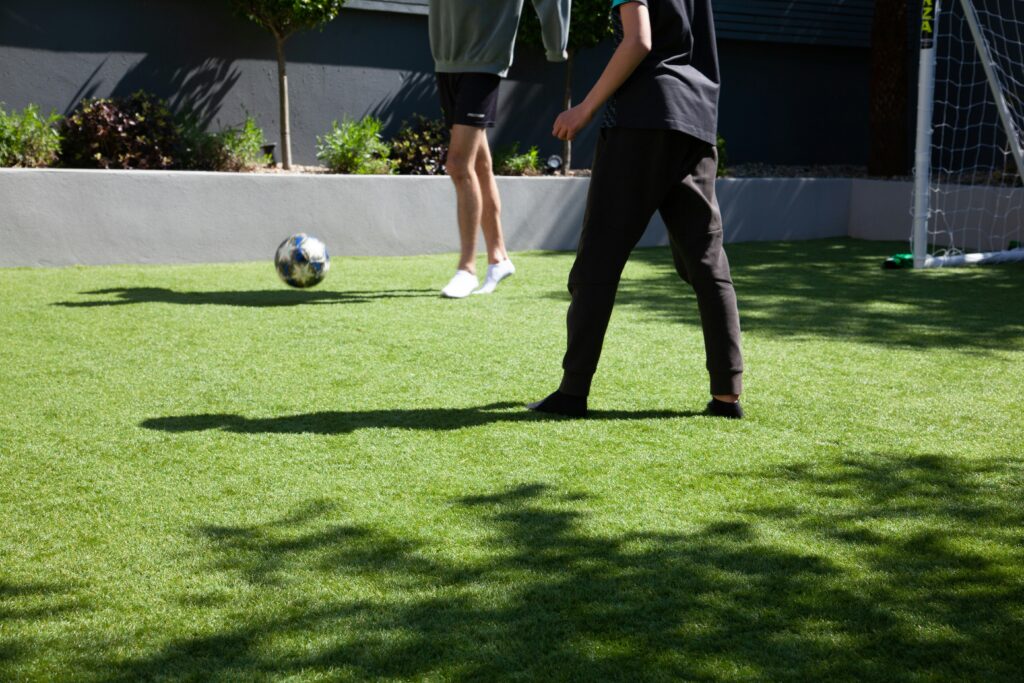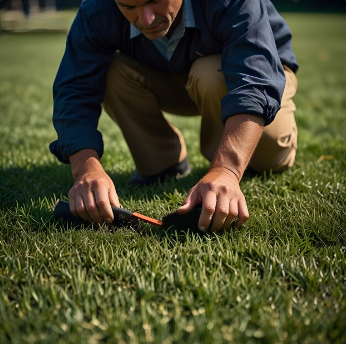Artificial Turf for Athletic Field
When you’re planning to build a Athletic Field, choosing the right surface is one of the most important decisions you will make. The surface you select impacts everything from the quality of play to the safety of athletes and even the maintenance costs. While natural grass is the traditional choice, artificial turf has become increasingly popular for athletic fields. This is because of Artificial Turf for Athletic Field have many benefits, including durability, low maintenance, and eco-friendliness. In this article, we will explore why artificial turf is the best option for your new athletic field and how it can save you money in the long run.
At Atlanta Artificial Grass Co, based in Atlanta, Georgia, we specialize in installing artificial grass. We have the experience and expertise to help you create the perfect athletic field for your needs. Whether you are building a new field or upgrading an existing one, we are here to provide you with the highest quality artificial turf solutions.

What is Artificial Turf?
Artificial turf is a surface made of synthetic fibers designed to look and feel like natural grass. Unlike natural grass, which can wear down over time, artificial turf is made to withstand heavy use and last for many years. It is used in a variety of settings, including sports fields, playgrounds, and even residential lawns.
Artificial turf is made up of several layers. The top layer is made of synthetic grass blades that are designed to mimic the look and feel of natural grass. These blades are usually made of polyethylene or polypropylene, which are durable and resistant to wear and tear. Beneath the grass blades is a layer of infill, which is usually made of rubber granules or sand. This infill helps to support the grass blades, provides cushioning, and gives the turf a natural feel. Finally, there is a backing layer that holds everything together and provides stability.
Why Choose Artificial Turf for Athletic Field?

There are many reasons why artificial turf is the best choice for your athletic field. Here are some of the top benefits:
1. Long-Lasting and Durable
One of the biggest advantages of artificial turf for athletic field is its durability. Unlike natural grass, which can wear down and develop bare spots, artificial turf is made to last. It can withstand heavy use without showing signs of wear and tear. This is especially important for athletic fields, where the surface needs to be in top condition for every game and practice.
Artificial turf is designed to be tough and resilient. It can handle the constant pounding of players running, jumping, and sliding without getting damaged. This means that your field will stay in great shape for many years, even with regular use. This durability makes artificial turf a great long-term investment for your athletic field.
2. Low Maintenance
Maintaining a natural grass requires a lot of time, effort, and money. You need to mow the grass regularly, water it, and apply fertilizers and pesticides to keep it healthy. You also have to deal with weeds and pests, which can be a constant battle. All of this maintenance takes up a lot of resources and can be a big hassle.
With artificial turf for athelic field, maintenance is much easier. You don’t need to mow or water it, and you don’t have to worry about weeds or pests. The only maintenance artificial turf requires is occasional brushing to keep the grass blades upright and remove any debris. This low-maintenance aspect is a huge advantage for busy organizations that don’t have the time or resources to take care of a natural grass field.
In addition to saving time, artificial turf for athletic field also saves money. Because it doesn’t require watering, mowing, or fertilizing, you’ll save on water bills, lawn care equipment, and chemicals. This makes artificial turf a cost-effective option in the long run.
3. Consistent Playing Surface
Another major benefit of artificial turf is that it provides a consistent playing surface. With natural grass, the field can become uneven over time as the grass wears down and develops bare spots. This can affect the quality of play and increase the risk of injuries.
Artificial turf, on the other hand, stays even and smooth throughout the year. The synthetic grass blades are designed to mimic the look and feel of natural grass while providing a level surface that enhances gameplay. This consistency is especially important for competitive sports, where the quality of the playing surface can have a big impact on performance.
By choosing artificial turf for athletic field, you’re ensuring that athletes have the best possible conditions for success. The even surface of artificial turf helps to reduce the risk of injuries and provides a better playing experience for everyone.
4. Weather Resistance
Weather conditions can have a big impact on the usability of natural grass fields. Rain can make the field muddy and slippery, while extreme heat can cause the grass to dry out and become brittle. These challenges can lead to frequent game cancellations and increased maintenance costs.
Artificial turf is designed to withstand all types of weather, making it a versatile option for year-round use. The turf has excellent drainage capabilities, which means that rainwater flows through quickly, preventing the formation of puddles and mud. This allows games and practices to continue even after heavy rainfall, reducing the likelihood of cancellations due to poor field conditions.
In addition to being resistant to rain, artificial turf is also UV-stabilized, which means it won’t fade or degrade under the harsh sun. This ensures that your field remains vibrant and attractive, even during the hottest months of the year.
5. Environmentally Friendly
While it might seem surprising, artificial turf can actually be an eco-friendly choice for your new athletic field. Natural grass requires a lot of water, fertilizers, and pesticides to stay healthy. These chemicals can have a negative impact on the environment, contributing to water pollution and harming local wildlife.
Artificial turf, on the other hand, eliminates the need for these harmful chemicals. It also conserves water because it doesn’t require regular watering to stay green and lush. In areas like Atlanta, where water conservation is important, artificial turf offers a sustainable solution that reduces your environmental footprint.
By choosing artificial turf, you’re making a more sustainable choice that benefits both your organization and the planet.
Customizing Your Artificial Turf Field

When planning the installation of artificial turf for athletic field, it’s important to consider the specific needs of your facility. Different sports have different requirements, and choosing the right type of artificial turf can make a big difference in the performance and safety of your field.
1. Choosing the Right Turf for Your Sport
The type of sport played on the field is one of the most important factors to consider when choosing artificial turf. Different sports have different demands, and the turf you select should be suited to the specific needs of your athletes.
Football and Soccer: For sports like football and soccer, you’ll need turf that can handle heavy use and provide a safe playing surface. Look for artificial turf with a thick, cushioned backing that offers shock absorption to reduce the impact on players’ joints. The turf should also have a dense pile height to provide a realistic ball roll and prevent injuries.
Baseball and Softball: Baseball and softball fields require turf with a shorter pile height to allow for fast ball speeds and easy sliding. The turf should also be designed to minimize the risk of “bad hops” and provide a consistent surface for fielders.
Multi-Sport Fields: If your athletic field will be used for multiple sports, you’ll need a versatile artificial turf that can accommodate different types of play. Look for turf with a medium pile height and a durable backing that can handle a variety of sports without wearing down.
2. Choosing the Right Infill Material
The infill material used in artificial turf plays a crucial role in its performance and safety. Infill is typically made from rubber granules, sand, or a combination of both. It helps to support the turf fibers, provide cushioning, and enhance the overall feel of the field.
Rubber Infill: Rubber infill is commonly used in sports fields because it provides excellent shock absorption and helps to reduce the impact on players’ joints. It’s a great option for high-impact sports like football and soccer.
Sand Infill: Sand infill is another popular choice for artificial turf. It provides a firm playing surface and is often used in combination with rubber infill to create a balanced field that offers both cushioning and stability.
Organic Infill: For those looking for an eco-friendly option, organic infill made from natural materials like coconut husks or cork is available. This type of infill is biodegradable and provides a softer, more natural feel underfoot.
3. The Installation Process of Artificial Turf for Athletic Field
The installation process of artificial turf for athletic field is critical to its performance and longevity. Proper installation ensures that the turf is level, well-drained, and securely anchored to the ground. Here’s an overview of the key steps involved in installing artificial turf:
Site Preparation: Before the turf can be installed, the site must be prepared. This includes removing any existing grass or vegetation, leveling the ground, and installing a drainage system to prevent water buildup.
Base Installation: A stable base is essential for the proper performance of artificial turf. The base is typically made from crushed stone or gravel, which is compacted to create a solid foundation.
Turf Installation: Once the base is in place, the artificial turf is rolled out and carefully positioned. The seams between turf sections are glued or stitched together, and the edges are anchored to prevent shifting.
Infill Application: After the turf is installed, the infill material is spread evenly across the surface. This helps to support the turf fibers, provide cushioning, and enhance the overall feel of the field.
Final Grooming: The final step in the installation process is grooming the turf to ensure that the fibers are upright and the infill is evenly distributed. This gives the field a polished, professional look.
Why Choose Atlanta Artificial Grass Co. for installing your artificial turf for athletic field ?
At Atlanta Artificial Grass Co, we pride ourselves on providing top-quality artificial turf installation services in Atlanta, Georgia. We understand that every athletic field is unique, and we’re committed to delivering customized solutions that meet your specific needs.
Our team of experienced professionals is dedicated to ensuring that your Artificial Turf for Athletic Field is installed to the highest standards. From selecting the right turf to overseeing the installation process, we take care of every detail to ensure that your field is ready for action.
When you choose Atlanta Artificial Grass Co, you’re choosing a partner who will work with you every step of the way to create a durable, low-maintenance, and environmentally friendly athletic field that will serve your community for years to come.
Conclusion
Artificial turf for Athletic Field is an excellent choice for athletic field. Artificial Turf for Athletic Field is durability, low maintenance, consistent playing surface, weather resistance, and environmental benefits make it a smart investment for any organization. By choosing artificial turf, you’re ensuring that your field will be ready for play in all conditions, while also saving time, money, and resources in the long run.
At Atlanta Artificial Grass Co, we’re here to help you create the perfect Artificial Turf for Athletic Field. With our expertise in artificial turf installation and our commitment to quality, you can trust us to deliver a field that meets your expectations and exceeds your athletes’ needs. Get your Artificial Turf for Athletic Field
Contact us today to learn more about how we can help you with your artificial turf project in Atlanta, Georgia. We look forward to working with you to create a artificial grass for athletic field that your community will be proud of.
